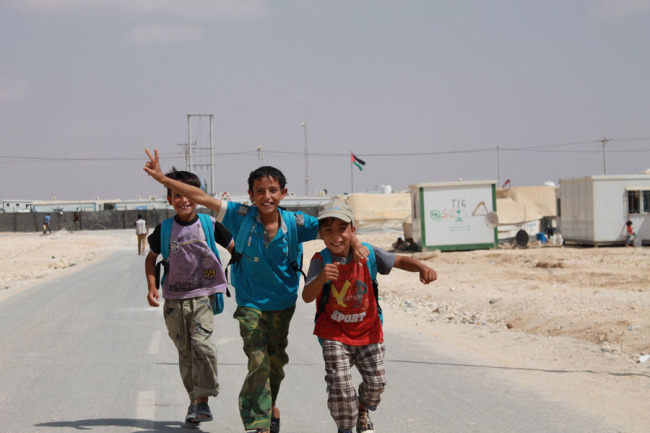“I was shot in my stomach. Seven bullets. I was a civilian at a checkpoint, and they said, ‘This checkpoint is freed by the rebellion, it’s all right.’ And I walked in and there were four Syrian Army snipers on the roof, and they shot me.”
He was treated in Jordan, where his kidney was removed. He returned to Syria three months later. He wanted to fight in the rebellion. After he was shot again, he left for Jordan with his family. He’s lived in the Zaatari refugee camp for a year now.
So went the stories of loss of many in the camp. Eighty-one thousand Syrians living in a vacuum of the poverty of war, displacement and uncertainty, less than eight miles south of the border to their homeland.
Comparatively, those working at nongovernmental organizations in the camp say Zaatari is relatively advanced, for a refugee camp. There is electricity, albeit temperamental, that can heat small stoves and fans in a family’s tent or aluminum boxcar. Food is bought with vouchers given to the refugees to allow their own picking and choosing in the markets rather than in-kind food allotments that were used before. There are three schools that have a total capacity of 15,000, in addition to a vocational schooling program for those who are not eligible to return to traditional schooling.
But stepping further inside and speaking with those living the reality, it is realized there is key wording in the earlier statement. Families of four, five, eight live in tents or boxcars no bigger than a small master bedroom. Food is limited; there is little work to afford food beyond the vouchers given, and there is talk of cutting down already low payments. One of the biggest concerns is the absence of sanitary irrigation—waste and trash gather in streams between the tents, creating a breeding ground for disease and bacteria. Being so close to the border, you can some days hear of the shelling on Dara’a, where the majority of refugees are from.
A number of the young men in the camp talk about returning to fight. They want to defeat Bashar. They want to join their friends, who remained in Syria with the rebellion. Residents speak to friends and family atop “Syria-Tel”, a hill in Zaatari where Syrian cell signal can be received and SIM cards from home used to call back and receive the news of war first-hand.
And within this microcosm of war-torn aftermath is a side of Zaatari that too often goes unspoken in media coverage. It is resilience, solidarity, loss and triumph. There is a certain joy from the children and a certain hope from the adults. All laying between the tents and aluminum containers in which live the 81,000, just a portion of all whom the Jordanian government has opened its borders to.

Jordan is largely a country of refugees. Palestinians first began coming over in 1948, with waves since with every additional Israeli conflict. Lebanese immigrated into Jordan during their civil war, and the Iraqis came both at the invasion of Kuwait and in 2003 upon U.S. invasion. Now, the country is hosting more than 600,000 Syrians registered with the United Nations High Commission for Refugees, with that number increasing with those unregistered in the country.
Jordan is also the third most water-poor country in the world. It is largely a country of desert, with few—if any—resources itself. The country cannot maintain economic stability, not to mention security in the face of expanding extremist threats, when caring for more than one million additional residents than it had two years ago on its own. In the absence of substantial international aid, this small country—which serves as an oasis in its neighborhood of severe turmoil—is left to bear the brunt of caring for a crisis that it does not have the humanitarian neglect to turn away.








